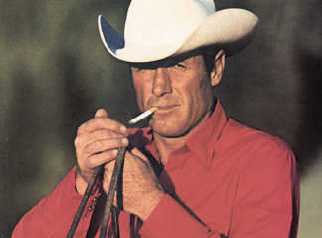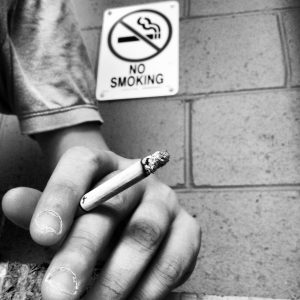
The Easter Sunday Parade in New York City was typically a tame event, yet the 1929 parade saw a drastic change as women boldly marched down the avenues of New York City with cigarettes in hand. Advertised as “torches of freedom”, cigarettes became one of the first status symbols which transcended gender roles and became a universal symbol of modernity in America.

Marred by decades of public health scandals and a television advertisement ban, cigarette culture has since become widely fragmented and deglamorized.
Before cigarettes were revealed to be carcinogenic and the Surgeon General’s warning was stamped on every carton, everyone in the America media from Fred Flintstone to Ronald Reagan could be seen coolly exhaling cigarette smoke wherever they went.
In 2012 researches from the Harvard School of Public Health surveyed approximately 14,000 students from 119 American colleges, and found that 23 percent claimed they had smoked in the past year, while 9 percent claimed they were current cigarette smokers.
This trend is easy to see at Georgia State as the recent smoking ban has had little to no effect on the number of cigarette butts lining the plant beds and trash cans in the Courtyard.
Why have cigarettes retained their appeal despite the tarnishing of their public image?
“When I started smoking in high school it was the cool thing to do, but now for me it’s more of the habit, I’m not doing it because it’s cool,” junior and geology major Jay Kirkland said.
Cigarette smoking has remained steady among Georgia State students, but the glamour has been replaced by a need for stress relief and an outlet for socializing.
“I think smoking is more of a stress thing. People who have been smoking for awhile will come out here and smoke cigarettes to collect their thoughts and get things organized for the next test they have to do. That’s what I use it for anyways,” Kirkland said.
Despite the scientific consensus that cigarettes increase long-term stress, many students use the instant gratification of a quick cigarette break to ease the anxiety of schoolwork.
“It is definitely a stress release, something to keep our mind off books and studying, a way to take a break,” said junior and business finance major William Perez.
Many college students also self-identify as social smokers, who use cigarette smoking as a way to easily make friends with people who they would not have met otherwise.
“I’m mostly a social smoker because there’s nothing else to do, when you’re on our break there’s nothing you can really do but come out here in the courtyard and smoke. It’s an easy conversation starter,” said junior and risk management major John Dapice.
Yet the identity of a social smoker can be problematic as it pacifies social smokers into believing that they lead healthier lifestyles than daily smokers.
A 2007 study published in Nicotine & Tobacco Research found that college students who identified as social smokers smoked nearly as frequently as those who claimed to smoke daily. Social smokers also were less likely to believe that smoking was addictive and they preferred to smoke while drinking alcohol.
The study found that those who denied being smokers commonly identified as being party smokers and still had their smoking habits correlated with other high-risk behaviors.
Social smokers often found college smoking campaigns which used traditional anti-smoking messages to be irrelevant and failed to convince them to quit.
Anti-smoking campaigns need to start targeting social smokers and focus on how infrequent party smoking can still lead to lung cancer and be exacerbated by heavy drinking.
Now that the Marlboro Man has passed away from lung cancer and the sex appeal of cigarettes has given way to photos of black lungs, cigarette culture has lost its once powerful hold on American consumers.
For current college smokers, it seems that the appeal of cigarettes has shifted from a symbol of modern chic to a need for effortless social interaction and a fleeting moment of solace among the stressful shuffle of college life.
TIMELINE
1902: The Phillip Morris Company creates the Marlboro brand.
1929: Advertising expert Edward Bernays organizes the “Torches of Freedom” campaign where cigarette smoking women march in New York’s Easter Parade.
1944: Due in part to World War II cigarette production rises to 300 billion a year.
1954: The Marlboro Man is introduced to sell filtered cigarettes to men.
1960: Fred and Wilma Flintstone light up Winston cigarettes during the closing credits of The Flintstones.
1964: The Surgeon General claimed that the tar and nicotine in cigarettes causes lung cancer.
1965: Congress passes the Cigarette Labeling and Advertising Act which mandated that every cigarette pack have a warning stating that “Cigarettes may be hazardous to your health.”
1970: The Public Cigarette Smoking Act bans cigarette advertisements on radio and television.
1975: Brown & Williamson introduce the “light” cigarette, claiming it has lesser amounts of tar and nicotine.
1981: Phillip & Morris begin actively targeting teenagers.
1984: The Comprehensive Smoking Education Act forces cigarette companies to rotate four different Surgeon General warning labels on cigarette packs every three months.
1992: Former Marlboro Man Wayne McLaren dies from lung cancer.
2009: Congress bans cigarette companies from using the terms “light”, “low-tar”, and “mild”.
Story idea submitted by Binh Siu, Senior
